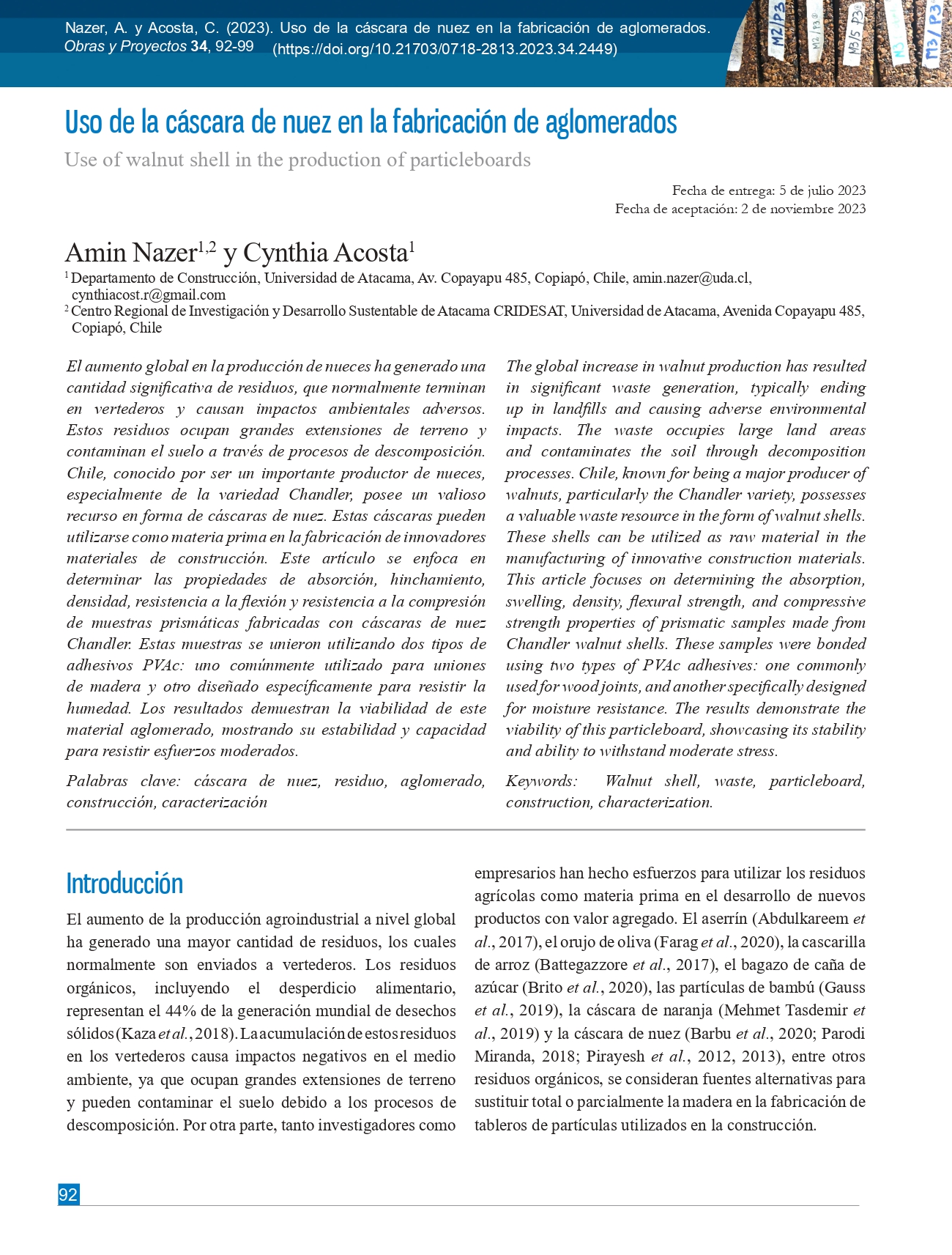Use of walnut shell in the production of particleboards
DOI:
https://doi.org/10.21703/0718-2813.2023.34.2449Keywords:
Walnut shell, waste, particleboard, construction, characterization.Abstract
The global increase in walnut production has resulted in significant waste generation, typically ending
up in landfills and causing adverse environmental impacts. The waste occupies large land areas
and contaminates the soil through decomposition processes. Chile, known for being a major producer of
walnuts, particularly the Chandler variety, possesses a valuable waste resource in the form of walnut shells.
These shells can be utilized as raw material in the manufacturing of innovative construction materials.
This article focuses on determining the absorption, swelling, density, flexural strength, and compressive
strength properties of prismatic samples made from Chandler walnut shells. These samples were bonded
using two types of PVAc adhesives: one commonly used for wood joints, and another specifically designed
for moisture resistance. The results demonstrate the viability of this particleboard, showcasing its stability
and ability to withstand moderate stress.
References
Abdulkareem, S.A., Raji, S.A. and Adeniyi, A.G. (2017). Development of particleboard from waste styrofoam and sawdust. Nigerian Journal of Technological Development 14(1), 18-22
ASTM D1037 (1999). Standard test methods for evaluating properties of wood-based fiber and particle materials. American Society of Testing and Materials, West Conshohocken, PA, USA
Barbu, M.C., Sepperer, T., Tudor, E.M. and Petutschnigg, A. (2020). Walnut and hazelnut shells: untapped industrial resources and their suitability in lignocellulosic composites. Applied Sciences 10(18), 6340
Battegazzore, D., Alongi, J., Frache, A., Wågberg, L. and Carosio, F. (2017). Layer by layer-functionalized rice husk particles: A novel and sustainable solution for particleboard production. Materials Today Communications 13, 92–101
Brito, F.M.S., Bortoletto Júnior, G., Paes, J.B., Belini, U.L. and Tomazello-Filho, M. (2020). Technological characterization of particleboards made with sugarcane bagasse and bamboo culm particles. Construction and Building Materials 262, 120501
ECHA (2018). Formaldehyde and formaldehyde releasers- Strategy for future work. European Chemicals Agency ECHA, Helsinki, Finland
FAO. (2019). Estadísticas de productos forestales. Organización de las Naciones Unidas para la Alimentación y la Agricultura, Roma, Italia
FAO (2020). Cultivos. Nueces con cáscara. Organización de las Naciones Unidas para la Alimentación y la Agricultura, Roma, Italia Farag, E., Alshebani, M., Elhrari, W., Klash, A. and Shebani, A.
(2020). Production of particleboard using olive stone waste for interior design. Journal of Building Engineering 29, 101119
Frihart, C. (2012). Wood adhesion and adhesives. Handbook of Wood Chemistry and Wood Composites, R.M. Rowell (ed.), 2nd ed., Boca Raton, FL, USA, CRC Press, 255–320
Gauss, C., de Araujo, V., Gava, M., Cortez-Barbosa, J. and Junior, H.S. (2019). Bamboo particleboards: Recent developments. Pesquisa Agropecuária Tropical 49, e55081
Gürü, M., Atar, M. and Yildirim, R. (2008). Production of polymer matrix composite particleboard from walnut shell and improvement of its requirements. Materials & Design 29(1), 284–287
Hilal, N., Mohammed Ali, T.K. and Tayeh, B.A. (2020). Properties of environmental concrete that contains crushed walnut shell as partial replacement for aggregates. Arabian Journal of Geosciences 13(16), 812
Kaza, S., Yao, L., Bhada-Tata, P. and Van Woerden, F. (2018). What a waste 2.0. A global snapshot of solid waste management to 2050. International Bank for Reconstruction and Development. The World Bank, Washington DC, USA
Kowaluk, G. and Fuczek, D. (2009). PVAc glue as a binding agent in particleboards. Drewno 52(182), 17–24
Martínez, M.L., Moiraghi, L., Agnese, M. and Guzman, C. (2003). Making and some properties of activated carbon produced from agricultural industrial residues from Argentina. The Journal of the Argentine Chemical Society 91(4–6), 103–108
Mehmet Tasdemir, H., Sahin, A., Karabulut, A.F. and Guru, M. (2019). Production of useful composite particleboard from waste orange peel. Cellulose Chemistry and Technology 53(6), 517–526
Orue, A., Eceiza, A. and Arbelaiz, A. (2020). The use of alkali treated walnut shells as filler in plasticized poly (lactic acid) matrix composites. Industrial Crops and Products 145, 111993
Parodi Miranda, D. (2018). Material compuesto a partir del residuo cáscara de nuez Juglans regia. Revista Chilena de Diseño: Creación y Pensamiento 3(5), 1–13
Pirayesh, H., Khanjanzadeh, H. and Salari, A. (2013). Effect of using walnut/almond shells on the physical, mechanical properties and formaldehyde emission of particleboard. Composites Part B: Engineering 45(1), 858–863
Pirayesh, H., Khazaeian, A. and Tabarsa, T. (2012). The potential for using walnut (Juglans regia L.) shell as a raw material for wood-based particleboard manufacturing. Composites Part B: Engineering 43(8), 3276–3280
Portalfrutícola (2017). https://www.portalfruticola.com/noticias/2019/09/27/guia-varietal-de-nueces-imagenes-ycaracteristicas/
Queirós, C.S.G.P., Cardoso, S., Lourenço, A., Ferreira, J., Miranda, I., Lourenço, M. J. V. and Pereira, H. (2020). Characterization of walnut, almond, and pine nut shells regarding chemical composition and extract composition. Biomass Conversion and Biorefinery 10(1), 175–188
Shah, A.H., Li, X., Xu, X.D., Wang, S., Bai, J.W., Wang, J. and Liu, W.B. (2018). Effect of alkali treated walnut shell (Juglans regia) on high performance thermosets. Study of curing behavior, thermal and thermomechanical properties. Digest Journal of Nanomaterials and Biostructures 13(3), 857–873
Solt, P., Konnerth, J., Gindl-Altmutter, W., Kantner, W., Moser, J., Mitter, R. and van Herwijnen, H. W.G. (2019). Technological performance of formaldehyde-free adhesive alternatives for particleboard industry. International Journal of Adhesion and Adhesives 94, 99–131
Stefanowski, B.K., Curling, S.F. and Ormondroyd, G.A. (2017). Assessment of lignocellulosic nut wastes as an absorbent for gaseous formaldehyde. Industrial Crops and Products 98, 25–28
Trischler, J. and Sandberg, D. (2014). Monocotyledons in particleboard production: Adhesives, additives, and surface modification of reed canary grass. BioResources 9(3), 3919–3938
Velasco, J. (2018). Cómo llegar a las 200 mil toneladas de nueces. En Nogales y otros frutales de nuez. Redagrícola.com Warcok, F. (2007). Nowe trendy w produkcji srodkow wiazacych w swietle wymagan Unii Europejskiej dotyczacych emisji formaldehydu. Biul. Inf. Ośrodka Badaw. Przem. Płyt Drewnopochodnych w Czarnej Wodzie, 47(1–2), 35-42 (en Polaco)

Downloads
Published
How to Cite
Issue
Section
License

This work is licensed under a Creative Commons Attribution-NonCommercial 4.0 International License.







